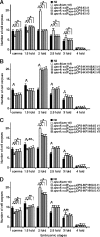Structural insights into apoptotic DNA degradation by CED-3 protease suppressor-6 (CPS-6) from Caenorhabditis elegans
- PMID: 22223640
- PMCID: PMC3293555
- DOI: 10.1074/jbc.M111.316075
Structural insights into apoptotic DNA degradation by CED-3 protease suppressor-6 (CPS-6) from Caenorhabditis elegans
Abstract
Endonuclease G (EndoG) is a mitochondrial protein that traverses to the nucleus and participates in chromosomal DNA degradation during apoptosis in yeast, worms, flies, and mammals. However, it remains unclear how EndoG binds and digests DNA. Here we show that the Caenorhabditis elegans CPS-6, a homolog of EndoG, is a homodimeric Mg(2+)-dependent nuclease, binding preferentially to G-tract DNA in the optimum low salt buffer at pH 7. The crystal structure of CPS-6 was determined at 1.8 Å resolution, revealing a mixed αβ topology with the two ββα-metal finger nuclease motifs located distantly at the two sides of the dimeric enzyme. A structural model of the CPS-6-DNA complex suggested a positively charged DNA-binding groove near the Mg(2+)-bound active site. Mutations of four aromatic and basic residues: Phe(122), Arg(146), Arg(156), and Phe(166), in the protein-DNA interface significantly reduced the DNA binding and cleavage activity of CPS-6, confirming that these residues are critical for CPS-6-DNA interactions. In vivo transformation rescue experiments further showed that the reduced DNase activity of CPS-6 mutants was positively correlated with its diminished cell killing activity in C. elegans. Taken together, these biochemical, structural, mutagenesis, and in vivo data reveal a molecular basis of how CPS-6 binds and hydrolyzes DNA to promote cell death.
Figures








Similar articles
-
Crystal structure of endonuclease G in complex with DNA reveals how it nonspecifically degrades DNA as a homodimer.Nucleic Acids Res. 2016 Dec 1;44(21):10480-10490. doi: 10.1093/nar/gkw931. Epub 2016 Oct 13. Nucleic Acids Res. 2016. PMID: 27738134 Free PMC article.
-
Oxidative Stress Impairs Cell Death by Repressing the Nuclease Activity of Mitochondrial Endonuclease G.Cell Rep. 2016 Jul 12;16(2):279-287. doi: 10.1016/j.celrep.2016.05.090. Epub 2016 Jun 23. Cell Rep. 2016. PMID: 27346342 Free PMC article.
-
Mechanisms of AIF-mediated apoptotic DNA degradation in Caenorhabditis elegans.Science. 2002 Nov 22;298(5598):1587-92. doi: 10.1126/science.1076194. Science. 2002. PMID: 12446902
-
CRN-1, a Caenorhabditis elegans FEN-1 homologue, cooperates with CPS-6/EndoG to promote apoptotic DNA degradation.EMBO J. 2003 Jul 1;22(13):3451-60. doi: 10.1093/emboj/cdg320. EMBO J. 2003. PMID: 12840007 Free PMC article.
-
2:1 Stoichiometry of the CED-4-CED-9 complex and the tetrameric CED-4: insights into the regulation of CED-3 activation.Cell Cycle. 2006 Jan;5(1):31-4. doi: 10.4161/cc.5.1.2263. Epub 2006 Jan 18. Cell Cycle. 2006. PMID: 16294007 Review.
Cited by
-
Structure and function of TatD exonuclease in DNA repair.Nucleic Acids Res. 2014;42(16):10776-85. doi: 10.1093/nar/gku732. Epub 2014 Aug 11. Nucleic Acids Res. 2014. PMID: 25114049 Free PMC article.
-
Structure-based domain assignment in Leishmania infantum EndoG: characterization of a pH-dependent regulatory switch and a C-terminal extension that largely dictates DNA substrate preferences.Nucleic Acids Res. 2017 Sep 6;45(15):9030-9045. doi: 10.1093/nar/gkx629. Nucleic Acids Res. 2017. PMID: 28911117 Free PMC article.
-
Crystal structure of endonuclease G in complex with DNA reveals how it nonspecifically degrades DNA as a homodimer.Nucleic Acids Res. 2016 Dec 1;44(21):10480-10490. doi: 10.1093/nar/gkw931. Epub 2016 Oct 13. Nucleic Acids Res. 2016. PMID: 27738134 Free PMC article.
-
Characterization of a cell death-inducing endonuclease-like venom protein from the parasitoid wasp Pteromalus puparum (Hymenoptera: Pteromalidae).Pest Manag Sci. 2021 Jan;77(1):224-233. doi: 10.1002/ps.6011. Epub 2020 Aug 6. Pest Manag Sci. 2021. PMID: 32673424 Free PMC article.
-
Anti-ROR1 scFv-EndoG as a Novel Anti-Cancer Therapeutic Drug.Asian Pac J Cancer Prev. 2018 Jan 27;19(1):97-102. doi: 10.22034/APJCP.2018.19.1.97. Asian Pac J Cancer Prev. 2018. PMID: 29373898 Free PMC article.
References
-
- Cummings O. W., King T. C., Holden J. A., Low R. L. (1987) Purification and characterization of the potent endonuclease in extracts of bovine heart mitochondria. J. Biol. Chem. 262, 2005–2015 - PubMed
-
- Low R. L. (2003) Mitochondrial endonuclease G function in apoptosis and mtDNA metabolism. A historical perspective. Mitochondrion 2, 225–236 - PubMed
-
- Parrish J., Li L., Klotz K., Ledwich D., Wang X., Xue D. (2001) Mitochondrial endonuclease G is important for apoptosis in C. elegans. Nature 412, 90–94 - PubMed
-
- Li L. Y., Luo X., Wang X. (2001) Endonuclease G is an apoptotic DNase when released from mitochondria. Nature 412, 95–99 - PubMed
Publication types
MeSH terms
Substances
Associated data
- Actions
Grants and funding
LinkOut - more resources
Full Text Sources
Molecular Biology Databases

